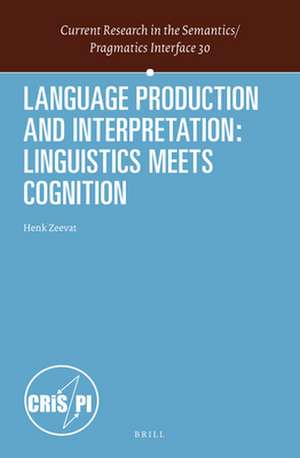Language Production and Interpretation: Linguistics meets Cognition: Current Research in the Semantics / Pragmatics Interface, cartea 30
Autor Henk Zeevaten Limba Engleză Hardback – 29 ian 2014
The importance of Henk Zeevat's new monograph cannot be overstated. Its combination of breadth, formal rigor, and originality is unparalleled in work on the form-meaning interface in human language...Zeevat's is the first proposal which provides a computationally feasible integrated treatment of production and comprehension for pragmatics, semantics, syntax, and even phonology. I recommend it to anyone who combines interests in language, logic, and computation with a sense of adventure. David Beaver, University of Texas at Austin
Din seria Current Research in the Semantics / Pragmatics Interface
- 18%
 Preț: 809.94 lei
Preț: 809.94 lei - 18%
 Preț: 1212.63 lei
Preț: 1212.63 lei - 18%
 Preț: 695.28 lei
Preț: 695.28 lei - 18%
 Preț: 732.97 lei
Preț: 732.97 lei - 18%
 Preț: 894.76 lei
Preț: 894.76 lei - 18%
 Preț: 652.18 lei
Preț: 652.18 lei - 18%
 Preț: 711.50 lei
Preț: 711.50 lei - 18%
 Preț: 651.32 lei
Preț: 651.32 lei - 18%
 Preț: 606.12 lei
Preț: 606.12 lei - 18%
 Preț: 606.12 lei
Preț: 606.12 lei - 18%
 Preț: 829.47 lei
Preț: 829.47 lei - 18%
 Preț: 572.06 lei
Preț: 572.06 lei - 18%
 Preț: 724.88 lei
Preț: 724.88 lei - 18%
 Preț: 722.15 lei
Preț: 722.15 lei - 18%
 Preț: 1092.39 lei
Preț: 1092.39 lei - 18%
 Preț: 676.88 lei
Preț: 676.88 lei - 18%
 Preț: 776.94 lei
Preț: 776.94 lei - 18%
 Preț: 705.92 lei
Preț: 705.92 lei - 18%
 Preț: 547.19 lei
Preț: 547.19 lei - 18%
 Preț: 728.67 lei
Preț: 728.67 lei - 18%
 Preț: 926.84 lei
Preț: 926.84 lei - 18%
 Preț: 734.27 lei
Preț: 734.27 lei - 18%
 Preț: 694.47 lei
Preț: 694.47 lei - 18%
 Preț: 536.28 lei
Preț: 536.28 lei
Preț: 606.12 lei
Preț vechi: 739.17 lei
-18% Nou
Puncte Express: 909
Preț estimativ în valută:
115.98€ • 124.02$ • 96.70£
115.98€ • 124.02$ • 96.70£
Carte indisponibilă temporar
Doresc să fiu notificat când acest titlu va fi disponibil:
Se trimite...
Preluare comenzi: 021 569.72.76
Specificații
ISBN-13: 9789004252899
ISBN-10: 9004252894
Pagini: 220
Dimensiuni: 160 x 239 x 18 mm
Greutate: 0.5 kg
Editura: Brill
Colecția Brill
Seria Current Research in the Semantics / Pragmatics Interface
ISBN-10: 9004252894
Pagini: 220
Dimensiuni: 160 x 239 x 18 mm
Greutate: 0.5 kg
Editura: Brill
Colecția Brill
Seria Current Research in the Semantics / Pragmatics Interface
Cuprins
1 INTRODUCTION
1.1 Aristotelian Competence Grammars
1.1.1 Against ACG: Ambiguity
1.1.2 Against ACG: Time complexity
1.1.3 Against ACG: The gap between production and interpretation
1.2 Production Grammar
1.2.1 The primacy of production
1.3 Strategies for Coordination
1.4 Bayesian Interpretation
1.4.1 Simulated production in interpretation
1.4.2 Mirror neurons
1.5 Conclusion
1.6 The Other Chapters
2 SYNTAX
2.1 Optimality Theory
2.1.1 Reversing Production
2.2 Optimality-theoretic Syntax
2.2.1 Optimality-theoretic syntax for word order in Dutch
2.2.2 Provisional German
2.2.3 Provisional English
2.3 The Production Algorithm
2.3.1 Procedural interpretation of the constraints
2.4 Higher Level Generation
2.5 Other Issues
2.5.1 More Dutch
2.5.2 A worked example
2.5.3 Incremental syntax checking in interpretation
2.5.4 Quantification
2.6 Conclusion
3 SELF-MONITORING
3.1 Optional Discourse Markers
3.1.1 General Self-Monitoring
3.2 Word order freezing
3.3 Pronouns and Ellipsis
3.4 Differential Case Marking
3.5 A Case for Phonological Self-Monitoring?
3.6 Conclusion
4 INTERPRETATION
4.1 The Interpretation Algorithm
4.2 Vision and Pragmatics
4.2.1 Vision
4.2.2 Other cues
4.2.3 Pragmatics
4.2.4 Clark buys some nails
4.2.5 Scalar implicatures
4.2.6 Relevance implicatures
4.3 Conclusion
5 MENTAL REPRESENTATION
5.1 From links to representation structures
5.2 Logic
5.2.1 Logical operators
5.3 Mental Representations in Philosophy
5.4 Belief
5.5 Definiteness
5.6 Comparison with Discourse Semantics
5.6.1 From Contexts into Discourse Representation Theory
5.7 Conclusion
6 Final Remarks 161
6.1 Rounding off
6.2 Computational Linguistics
6.3 Pragmatics
6.4 Semantic Compositionality
6.5 LFG 3.0 and PrOT 2.0
6.6 Language Evolution
6.7 Conceptual Glue
1.1 Aristotelian Competence Grammars
1.1.1 Against ACG: Ambiguity
1.1.2 Against ACG: Time complexity
1.1.3 Against ACG: The gap between production and interpretation
1.2 Production Grammar
1.2.1 The primacy of production
1.3 Strategies for Coordination
1.4 Bayesian Interpretation
1.4.1 Simulated production in interpretation
1.4.2 Mirror neurons
1.5 Conclusion
1.6 The Other Chapters
2 SYNTAX
2.1 Optimality Theory
2.1.1 Reversing Production
2.2 Optimality-theoretic Syntax
2.2.1 Optimality-theoretic syntax for word order in Dutch
2.2.2 Provisional German
2.2.3 Provisional English
2.3 The Production Algorithm
2.3.1 Procedural interpretation of the constraints
2.4 Higher Level Generation
2.5 Other Issues
2.5.1 More Dutch
2.5.2 A worked example
2.5.3 Incremental syntax checking in interpretation
2.5.4 Quantification
2.6 Conclusion
3 SELF-MONITORING
3.1 Optional Discourse Markers
3.1.1 General Self-Monitoring
3.2 Word order freezing
3.3 Pronouns and Ellipsis
3.4 Differential Case Marking
3.5 A Case for Phonological Self-Monitoring?
3.6 Conclusion
4 INTERPRETATION
4.1 The Interpretation Algorithm
4.2 Vision and Pragmatics
4.2.1 Vision
4.2.2 Other cues
4.2.3 Pragmatics
4.2.4 Clark buys some nails
4.2.5 Scalar implicatures
4.2.6 Relevance implicatures
4.3 Conclusion
5 MENTAL REPRESENTATION
5.1 From links to representation structures
5.2 Logic
5.2.1 Logical operators
5.3 Mental Representations in Philosophy
5.4 Belief
5.5 Definiteness
5.6 Comparison with Discourse Semantics
5.6.1 From Contexts into Discourse Representation Theory
5.7 Conclusion
6 Final Remarks 161
6.1 Rounding off
6.2 Computational Linguistics
6.3 Pragmatics
6.4 Semantic Compositionality
6.5 LFG 3.0 and PrOT 2.0
6.6 Language Evolution
6.7 Conceptual Glue
Notă biografică
Henk Zeevat (PhD 1992 University of Amsterdam) is a senior lecturer in Amsterdam. He has worked on semantics, pragmatics and formal grammar and their implementation, especially on discourse semantics and optimality theoretic pragmatics.
